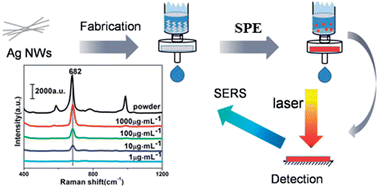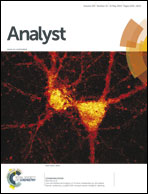A disordered silver nanowires membrane for extraction and surface-enhanced Raman spectroscopy detection†
Abstract
A disordered silver nanowires membrane combining solid-phase extraction (SPE) with surface-enhanced Raman spectroscopy (SERS) was used for the rapid collection and detection of food contaminants. The membrane was fabricated via filtration of the silver nanowires colloid solution, which was prepared by a solvothermal polyol process. Analytes in 5 mL of liquid phase were concentrated in less than 10 s due to their affinity for the silver nanowires on the filter membrane. The membrane combined the advantages of SPE and SERS technology for the analysis of food safety contaminants. The use of the SERS-active extraction membrane eliminated the procedure of elution, which shortened the time of analysis. It has been shown that the as-prepared membrane had good uniformity and high temporal stability under continuous laser irradiation. Qualitative and quantitative detection of phorate and melamine was further performed based on a flow-through method. The characteristic SERS intensity plotted against phorate and melamine concentrations exhibited a good linear relationship over the concentration range of 2.5 to 10 μg mL−1 (phorate) and 2.5 to 100 μg mL−1 (melamine).


 Please wait while we load your content...
Please wait while we load your content...